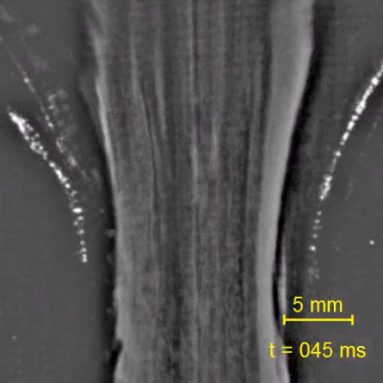Supersonic Splash
Coming soon to a pond near you: air moving faster than the speed of sound
Supersonic means faster than the speed of sound, which is about 760 miles per hour in air. That’s a speed limit that can be broken — by jets and bullets, for example, or by the space shuttle as it returns to Earth.
Now, a scientist named Stephan Gekle has found that you can make air move faster than the speed of sound by doing a simple little trick: throw a rock in a pond.
 |
|
View video | As a disc representing a stone plunges into still water, it plows out a column of air. The column collapses in an hourglass shape, and the escaping air (in the video, the air is filled with smoke for visibility) shoots thro |
| Stephan Gekle/Physical Review Letters 2010 |
Gekle is a scientist at the University of Twente in the Netherlands who studies the physics of fluids. Physics is the study of forces and motion, and Geckle investigates how forces act on liquids, like water. In a recent study, he and his colleagues showed that after a rock drops into a body of water, a tiny jet of air shoots upward faster than the speed of sound.
This isn’t the first time Gekle has explored what happens when a rock sinks through water. In an earlier study, he and his team showed that as a rock falls into a flat surface of water, like a pond, it carves out a tiny tube of air. This tube connects the sinking rock to the air above the pond. The tube doesn’t exist for very long, though — almost immediately, the surrounding water pushes on the sides. This pressure is stronger in the middle than at the ends. As a result, the tube looks like an hourglass, where the middle gets smaller and smaller as the water forces the air out.
There’s not room in the hourglass for water and air, so as the water comes in the air escapes upward — and fast. These tiny jets of air can blast faster than the speed of sound, Gekle found.
To measure these air jets is trickier than it may seem. Gekle and his colleagues had to do more than stand at the edge of a pond with stopwatches. A careful science experiment requires a scientist to take multiple measurements of the exact same thing, to check and double-check the results. In this case, it would have been almost impossible for Gekle and his colleagues to throw a rock in a pond in the same way over and over again.
Instead, the scientists created a lab experiment that acted like a rock falling through water: They dragged a circular disc down through water at the same speed, over and over again, and watched what happened.
But there was another difficulty: It’s hard to see and measure air. To solve that problem, the scientists filled the air above the water with smoke and illuminated the smoke with a laser, which made the moving air easier to see. (To make the smoke, Gekle said, they used a smoke machine like the ones that provide the dramatic effects seen onstage at theaters.)
Finally, because everything happens so fast when the rock moves through water, the scientists had to find a way to slow down time. As the disc moved through the water, the scientists took pictures with a camera that captured 15,000 frames every second. (That’s faster than most movie cameras.) After the experiment, the researchers could slow down the movie and, aided by computer simulations, calculate the speed of air as it blew out of the hourglass-shaped tube.
But there’s one aspect of supersonic air that Gekle and his team didn’t observe. When a jet exceeds the speed of sound, the air around it produces a noise like thunder, called a sonic boom. So far, however, Gekle says the tiny air jets aren’t making even a teeny, tiny boom — but the researchers will keep listening.
POWER WORDS (adapted from the Yahoo! Kids Dictionary)
speed of sound About 760 miles per hour, through air at sea level.
supersonic Faster than the speed of sound.
physics The science of matter and energy and of interactions between the two, grouped in traditional fields such as acoustics, optics, mechanics, thermodynamics and electromagnetism, as well as in modern fields including atomic and nuclear physics, solid-state physics, particle physics and plasma physics.
force The capacity to do work or cause physical change.
pressure Force applied uniformly over a surface, measured as force per unit of area.
Supersonic flows in action from Science News on Vimeo.
As a stone plows into still water, it plows out a column of air. The column collapses in an hourglass shape, and the escaping air (in this video, the air is filled with smoke for visibility) shoots through the shrinking opening at supersonic speeds.
Credit: Stephan Gekle/Physical Review Letters 2010
Going Deeper:







